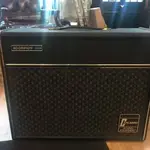E
ecc83
Well-known member
I am sorry Smithers but you have promulgated a few common myths and misnomers there.
There is no such thing as "RMS" watts. We measure electrical power as the product of an RMS VOLTAGE and an RMS CURRENT. The result is watts, pure and simple. Pedantry? Sure but I expect companies writing specifications to be electrically educated.
It is also a gross oversimplification to say transistors go into ***t or bust distortion and valves don't. The overload characteristics of any power amplifier depends upon how much or if any negative feedback is used. Because of the way transistor PAs are now made* they have to have a lot of NFB. Valve guitar amps have very little or even none (AC30 e.g.)
NFB keeps distortion low until a certain 'break point' then WHAMMO it shoots up. Such an amplifier would be of little use to a guitarist. However, hi fi VALVE amplifiers have this sudden rush of distortion much the same as solid state.
Valve amps ARE louder watt for published watt but not I would say in that 5 to 1 ratio. It is hard to specify since both amp types are so variable in design but 2 or 3 to 1 would be my bet. The higher volume of valves comes about mainly because they have a much higher output resistance than most SSTate amps. Typically for a 30W valve amp with no NFB Z out will be around 50 Ohms. Now, speaker voice coils get hot and thus their resistance increases. This is called "Thermal Compression" and if such a speaker is fed from a very low source resistance, i.e. a sstate amp, the current in the VC will fall and so therefore the input power. A valve stage will keep pumping in the current and thus keep the volume up.
*Not always the case. The venerable Quad 50E was essentially a transistor version of a valve circuit and you could I think remove or reduce the NFB and get a more gradual overload characteristic. LOVE to get my hands on one!
Dave.
There is no such thing as "RMS" watts. We measure electrical power as the product of an RMS VOLTAGE and an RMS CURRENT. The result is watts, pure and simple. Pedantry? Sure but I expect companies writing specifications to be electrically educated.
It is also a gross oversimplification to say transistors go into ***t or bust distortion and valves don't. The overload characteristics of any power amplifier depends upon how much or if any negative feedback is used. Because of the way transistor PAs are now made* they have to have a lot of NFB. Valve guitar amps have very little or even none (AC30 e.g.)
NFB keeps distortion low until a certain 'break point' then WHAMMO it shoots up. Such an amplifier would be of little use to a guitarist. However, hi fi VALVE amplifiers have this sudden rush of distortion much the same as solid state.
Valve amps ARE louder watt for published watt but not I would say in that 5 to 1 ratio. It is hard to specify since both amp types are so variable in design but 2 or 3 to 1 would be my bet. The higher volume of valves comes about mainly because they have a much higher output resistance than most SSTate amps. Typically for a 30W valve amp with no NFB Z out will be around 50 Ohms. Now, speaker voice coils get hot and thus their resistance increases. This is called "Thermal Compression" and if such a speaker is fed from a very low source resistance, i.e. a sstate amp, the current in the VC will fall and so therefore the input power. A valve stage will keep pumping in the current and thus keep the volume up.
*Not always the case. The venerable Quad 50E was essentially a transistor version of a valve circuit and you could I think remove or reduce the NFB and get a more gradual overload characteristic. LOVE to get my hands on one!
Dave.

